Union of Transylvania with Romania
The Union of Transylvania with Romania was declared on 1 December 1918 (N.S., 18 November O.S.) by the assembly of the delegates of ethnic Romanians held in Alba Iulia. The Great Union Day (also called Unification Day[1]), celebrated on 1 December, is a national holiday in Romania that commemorates this event. The holiday was established after the Romanian Revolution, and commemorates the unification not only of Transylvania, but also of Bessarabia and Bukovina and parts of Banat, Crișana and Maramureș with the Romanian Kingdom. Bessarabia and Bukovina had joined with the Kingdom of Romania earlier in 1918.
Part of a series on the |
|---|
| History of Romania |
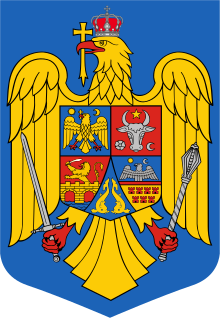 |
|
Post-Revolution |
|
|
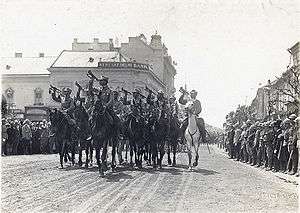
_in_Hungary%2C_census_1890.jpg)
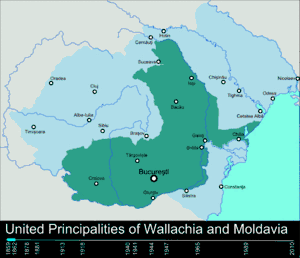
Causes and leading events
- August 17, 1916 - Romania signed a secret treaty with the Entente Powers (United Kingdom, France, Italy and Russia), according to which Transylvania, Banat, and Partium would become part of Romania after World War I if the country entered the war. The planned border followed a line some 20-40 kilometres west of the present Hungarian-Romanian border, but joined river Tisza in the South, thus granting the whole of Banat to Romania.
- August 27, 1916 Romania attacks Austria-Hungary. The offensive is soon halted by Austrian-Hungarian and German forces. In return, with a combined push from Transylvania and from Bulgaria, the Central Powers occupy Wallachia, including Bucharest. The Romanian capital temporarily moves to Iași.
- December 1916 - The German offensive is stopped along the Mărășești-Galați line.
- May–July 1917 - Romanian troops halt a German offensive and push them back to the last trench line, but lose the momentum.
- December 9, 1917 - Romania sign armistice with Central Powers
- January 1918 - US President Woodrow Wilson condemns any secret treaties and requests autonomy for the ethnic groups of Austria-Hungary.
- March 26–28, 1918 - A Congress of Nationalities of Austria-Hungary takes place in Rome. A motion is passed, demanding the recognition of the right of each nation to constitute into a national state, which would stay independent, or would unite with its already existing national state.
- April 9 [O.S. March 27] 1918 - Bessarabia, after a three-month independence from Russia, proclaims the Union with the Kingdom of Romania. Romanian and some minority deputies (86 in total) vote for, while the majority of the minorities' (Ukrainian, Russian, German, Jewish, Gagauz) representatives (36 in total) abstain. 2 Ukrainian and 1 Bulgarian deputies (3 in total) vote against. The declaration is co-signed by the (pro-German) prime-minister Alexandru Marghiloman for the Romanian government.
- May 18 [O.S. May 5] 1918 - A Peace Treaty is signed between the Central Powers (Germany, Austria-Hungary and Bulgaria) and the Kingdom of Romania, to replace the five-month-old armistice. Romania recovers its pre-war territory occupied by the Central Powers in December 1916, except for Dobruja and the mountain regions. The treaty is not ratified by Romania, in the hope that the tide of the war would turn the other way. The Central Powers, in accordance to the treaty, begin to pull out its troops from the occupied Wallachia.
- August 24, 1918 - A National Council of Romanian Unity is created in Paris, with Take Ionescu as president, Vasile Lucaciu, Octavian Goga, Dr. Constantin Angelescu and Ioan Theodor Florescu as members. It is recognized as "the exponent of the interests of the Romanian nation of Austria-Hungary" by France (September 29), the United States (October 23), the United Kingdom (October 29), and Italy (November 9), the four powers of the Entente.
- September 2, 1918 - A Congress of Czechs, Slovaks, Poles, Romanians, Serbs, Croatians, and Ruthenes of Austria-Hungary takes place in New York City. A resolution demanding the division of the Austria-Hungary and the liberation of its peoples is passed.
- October 12, 1918 - The Executive Committee of the Romanian National Party, the major party in Transylvania representing Romanians in the Kingdom of Hungary, takes place in Nagyvárad (Oradea). A declaration is passed, demanding the creation "in virtue of the national right of every nation to decide its own fate" of a Central National Romanian Council, a provisional governing body for Transylvania. To this end the Romanian National Party forms an Action Committee, seated in Arad, and presided by Vasile Goldiș.
- October 18, 1918 - Alexandru Vaida-Voevod, the preeminent Romanian politician in Austria-Hungary, reads the above Declaration of Self-determination in the Parliament of the Hungarian part of Austria-Hungary in Budapest.
- same day - Emperor Karl I puts forward a "Manifesto to my faithful peoples", about the reorganization of Austria-Hungary into a Federation of six independent states: Austrian, Hungarian, Czech, Yugoslav, Polish, and Ukrainian. The Manifesto fails to achieve its goal, being regarded as a step that comes way too late. National Councils spring up throughout Austria-Hungary, and prefer to negotiate directly with the Entente powers, rather than with the failing Central Government.
- same day - A reply to Emperor Karl I of Habsburg's Manifesto is passed by the Corps of the Transylvanian and Bukovinian Volunteers in the Austrian-Hungarian Army, which calls for a union of the territories inhabited by Romanians with the Kingdom of Romania. Iuliu Maniu, a preeminent Transylvanian politician, gathers in Vienna 70,000 Transylvanian soldiers from the Austrian-Hungarian Army, and takes them to Transylvania.
- October 31, 1918 - A new government, led by Károlyi Mihály is formed in Budapest, with the democrat Oszkár Jászi as Minister of Nationalities. The Hungarian government terminates its union with Austria, officially dissolving the Austro-Hungarian state.
- November 3, 1918 - General Weber, on behalf of Austria-Hungary, signs the armistice treaty in Padua, Italy.
- same day - Central National Romanian Council is created from representatives of the Romanian National Party and those of Social-Democrat Party of Transylvania, and takes control over the local authorities in Transylvania. The Hungarians administrative apparatus disintegrates. Károlyi Mihály’s Hungarian government enters negotiations with the Central National Romanian Council.
- November 6 [O.S. October 24] 1918 - As the Entente's victory on the Western Front seems more and more likely, and as the Army of General Maurice Sarrail from Salonica breaks through the Bulgarian lines on the Balkan Front, the Romanian pro-German government of Alexandru Marghiloman resigns. A new government, with General Constantin Coandă as Prime Minister, is formed. The general mobilization is decreed.
- November 10 [O.S. October 28] 1918 - Romania re-declares war on the Central Powers.
- November 9, 1918 - The Romanian National Council sent a memorandum to Budapest demanding the handover of Eastern-Hungary (above the historical Transylvania the counties of Torontál, Temes, Krassó Szörény, Arad, Bihar, Szilágy, Szatmár and Máramaros.[2]
- November 12, 1918 - The first Romanian troops enter Hungary and occupy the Gyergyótölgyes (Tulgheș) mountain pass accessing the Székely Land Region.
- November 13, 1918 - Armistice on the Balkan Front is signed in Belgrade, Serbia, between the French General Franchet d'Esperey, chief of the Entente's Oriental Army, and the Hungarian government. Small-scale military action continues for a few days in southern Hungary. The agreement fixes demarcation lines between Hungary, Serbia and Romania, according to which the region of Banat goes under Serbian administration, in spite of the 1916 secret treaty with Bucharest. Körösvidék (Crișana) and Máramaros (Maramureș), including the cities of Szatmárnémeti (Satu Mare), Nagyvárad (Oradea), Belényes (Beiuș), and Arad, as well as the inner Transylvania up to the river Maros (Mureș), are left under Hungarian administration. Hungary is required by the Entente Powers to allow Romanian troops to enter the Transylvanian territories east of the demarcation line along Mureș. Hungary is allowed to keep only 8 army divisions. Disarmed troops are returning home.
- November 13–15, 1918 - Negotiations are held in Arad between the Hungarian government of Károlyi Mihály and the Central National Romanian Council (of Transylvania), without reaching any agreement. News about the Belgrade agreement reach the Romanian (Transylvanian) delegation. The Central National Romanian Council retreats from negotiations and decides to hold elections and convey for November 18/December 1 the National Assembly of Romanians from Transylvania and Hungary, and to hand power to the latter.
- November 13–20, 1918 - Romanian troops occupy further major mountain passes on the North-Eastern border of Hungary. They have the intent to occupy up about 1/4 of the territory of Transylvania, as allotted by the November 13 armistice in Belgrade to pass under its temporary administration. Hungary pulls out troops to comply with the armistice treaty. Isolated armed clashes with the Hungarian military police occur.
- November 1918 - During a 12-day interval, elections are held for the National Assembly of Romanians of Transylvania and Hungary. Its 1,228 members are elected 5 each from the electoral districts established in 1910 (600 members in total), and 628 to represent different social, professional and cultural organizations (clergy, teachers' unions, military). The local enthusiasm gains momentum, as demands such as land reform, universal vote, and possible union with Romania are put forward.
- November 25, 1918 - The Romanian Army occupies Marosvásárhely (Târgu-Mureș), the most important town of Székely Land, in eastern Transylvania.
- November 28, 1918 - The National Assembly of Székelys in Marosvásárhely (Târgu-Mureș) reaffirms their support to the territorial integrity of Hungary.
- November 28, 1918 - The elected 100-member General Congress of Bukovina passes a resolution of unconditional union with the Kingdom of Romania. Romanian (74), German (7) and Polish (6)-speaking deputies vote for, while the 13 Ukrainian deputies leave before the final vote.
Alba Iulia National Assembly
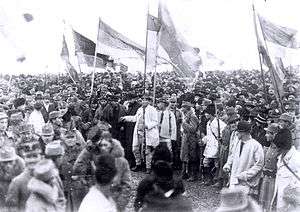
On 1 December 1918 (N.S., 18 November O.S.), the National Assembly of Romanians of Transylvania and Hungary, consisting of 1,228 elected representatives of Romanians in Transylvania, Banat, Crișana and Maramureș, convened in Alba Iulia and decreed (by unanimous vote):
- the unification of those Romanians and of all the territories inhabited by them with Romania.
The declaration included 26 counties of the Kingdom of Hungary.[3]
The Resolution[4] voted by the National Assembly stipulated also the "fundamental principles for the foundation of the new Romanian State":
- Full national freedom for all the co-inhabiting peoples. Each people will study, manage and judge in its own language by individual of its own stock and each people will get the right to be represented in the law bodies and to govern the country in accordance with the number of its people.
- Equal rights and full autonomous religious freedom for all the religions in the State.
- Full democratic system in all the realms of public life. Suffrage universal, direct, equal, secret, in each commune, proportionally, for both sexes, 21 years old at the representation in communes, counties or parliament.
- Full freedom of the press, association and meeting, free propaganda of all human thoughts.
- Radical agrarian reform. All the assets, above all the big ones, will be inscribed. The wills by which the heir consigns the land to a third party will be abolished; meanwhile, on the basis of the right to cut down estates freely, the peasant will be able to his own property (ploughing land, pasture, forest), at least one for him and his family to labour on. The guiding principle of this agrarian policy is promoting social evening, on the one hand, and giving force to production, on the other.
- The industrial workers will be granted the same rights and privileges that are in force in the most advanced western industrial states.
The union was conditional, and demanded the preservation of a democratic local autonomy, the equality of all nationalities and religions.

The Assembly also formed from 200 of its members, plus 50 co-opted members a High National Romanian Council of Transylvania, the new permanent parliament of Transylvania.
The next day, on 2 December 1918 the High National Romanian Council of Transylvania formed a government under the name of Directory Council of Transylvania (Consiliul Dirigent al Transilvaniei), headed by Iuliu Maniu.
On 11 December 1918, King Ferdinand signed the Law[5] regarding the Union of Transylvania, Banat, Crișana, the Satmar and Maramureș with the Old Kingdom of Romania, decreeing that:
- The lands named in the resolution of the Alba-Iulia National Assembly of the 18th of November 1918 are and remain forever united with the Kingdom of Romania.
Aftermath
Inner Transylvania and Maramureș
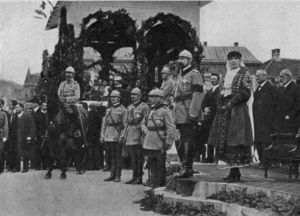
- December 7, 1918 - The Romanian Army enters Brașov (Brassó), in southeastern Transylvania.
- December 7, 1918 - General Henri Berthelot, the commander of the French Danubian forces, gave Romanian troops permission in early December to cross the Mures and occupy eight towns between Arad and Máramarossziget (Sighetu Marmației), but he long delayed informing the Hungarian government of this decision.[6] The Romanian Army is heading towards Torda (Turda), with the intention of occupying Kolozsvár (Cluj), the most important city in Transylvania. Hungary is ordered by the Entente Powers to further pull back its troops.
- December, 1918 - The Hungarian Government decides to recruit soldiers to be able to resist the advancing Romanian troops but the time is too short.
- December 12, 1918 - Romanian troops enter Nagyszeben (Sibiu) (southern Transylvania).
- December 14, 1918 - The Directory Council of Transylvania, elected by ethnic Romanians, sends a delegation headed by Miron Cristea, the Bishop of Caransebeș (Karánsebes), to Bucharest to negotiate the details of the Union. King Ferdinand I of Romania receives and accepts the Declaration of Union, passed on December 1 by the National Assembly of Romanians of Transylvania and Hungary.
- December 22, 1918 - In response, a Hungarian General Assembly in Cluj (Kolozsvár), central Transylvania, and the most important Hungarian town in Transylvania reaffirms the loyalty of Hungarians from Transylvania to Hungary.
- December 24, 1918 - As King Ferdinand I of Romania signs the decree sanctioning the Union of Bessarabia, of Bukovina, and of Transylvania with Romania, the Hungarian government protests. Romania starts negotiations in Versailles with the four Entente powers, as well as with Czechoslovakia, Hungary, Serbia, Bulgaria, and Russia for the establishment of the new border.
- December 24, 1918 - Romanian troops enter Cluj (Kolozsvár). Cluj and other major towns are surrendered with no resistance.
- January 1919 - Following a Romanian request, the Allied Command in the East under the leadership of the French general Franchet d'Esperey allows the Romanian Army to advance up to the line of the Western Carpathians. Entente negotiators in Versailles show open hostility towards the boldness of the actions of Romanians. Romanians in turn claim the decisions of the Parliament of Transylvania should have priority over the armistice agreements between France and Hungary.
- January 8, 1919 - A National Assembly of Germans of Transylvania and Banat is held in Mediaș (Medgyes), central Transylvania, and a declaration is passed to support the decision of the Romanians to unite with the Kingdom of Romania.[7][8]
- January 14, 1919 - Romanian troops reach Baia Mare.
- January 18, 1919 - The Romanian Army enters Sighetu Marmației.
- January 22, 1919 - Romanian troops now control the entire territory up to the new demarcation line indicated by the Entente powers. Inner Transylvania and Maramureș (Máramaros) are under Romanian control, leaving Banat under Serbian, and Crișana (Körösvidék) under Hungarian control.
Crișana and the Hungarian-Romanian War of 1919
- March 19, 1919 - French lieutenant-colonel Fernand Vix, on behalf of the Entente Powers, notifies Hungary of a new demarcation line to which the Romanian Army would advance. This line coincides with the railway line Satu Mare (Szatmárnémeti) - Oradea (Nagyvárad) - Arad, however the Romanian Army is not allowed to enter these cities. A demilitarized zone is to be created, stretching from there up to 5 km beyond the border marking the extent of the Romanian territorial requests on Hungary. The retreat of the Hungarian Army behind the westward border of the demilitarized zone is to begin on March 23, 1919.
- March 21, 1919 - Hungary's Prime Minister Károlyi says in an address to the people that he cannot accept the territorial losses that the Entente powers press on him to accept, and transfers the power to a radical left-wing government, headed by the Communist Béla Kun, who in turn proclaims Hungary a Soviet Republic, and renounces the passive policy of accepting territorial losses dictated by the Entente.
- March 1919 - The Romanian delegation at the Peace Conference in Paris, headed by Prime Minister Ion I.C. Brătianu, asks the Council of the Great Powers to allow Romania to occupy the territory up to the river Tisza (as agreed upon before Romania's entry into the war in 1916). The proposal is rejected. South-African General Jan Smuts is sent to Budapest to negotiate with Béla Kun.
- April 1919 - The discussion between Entente representatives and Kun government are stalled, as Kun requests that the Romanian Army fall back to the Mureș (Maros) river. More information about the anti-Romanian repression in the Romanian-inhabited areas still under Hungarian control reaches Bucharest. The Romanian Army is ordered by the Romanian government to prepare a general offensive for April 16, 1919 to force the Hungarian authorities to comply with the Allied council decision on February 28 concerning the new demarcation line. The battle plans are even more bold: according to them the overall advance is to stop only at the Tisza river.
- April 15, 1919, evening - Hungarian troops organize a preemptive strike against the Romanian Army in western Transylvania.
- April 16–19, 1919 - Violent battles take place in the Apuseni Mountains, eventually won by the Romanian troops (five divisions), which broke through the front lines into the Crișana Plain.
- April 19, 1919 - Following their successful counter-offensive against the Hungarian Soviet Republic, Romanian troops enter Carei (Nagykároly) and Satu Mare (Szatmárnémeti).
- April 20, 1919 - The Romanian Army enters Oradea (Nagyvárad) and Salonta (Nagyszalonta), reached the line set by the Allies in the Vix Note. However, the Romanian High Command decided to go over this line and advance to the Tisza river, for military reasons: Tisza makes a natural obstacle that is easy to defend, and at the same time the Hungarian Army was beaten but not destroyed. By doing so, the Romanians went against the wishes of the Allies.
- May 1, 1919 - The Romanian Army reaches the river Tisza.
- May 17, 1919 - Romanian army units enter Arad.
- June–July, 1919 - The Council of the Great Powers asks the Romanian government to retreat its troops to the (second) demarcation line and invites Béla Kun to Paris. Romania answers negative, and says it would agree to the demand if the Communist Hungarian Army is disarmed and demobilized. Béla Kun refuses this condition.
- July 17, 1919 - Béla Kun orders a counter-offensive against the Romanian Army.
- July 20, 1919 - The Hungarian Army crosses the Tisza; violent battles take place.
- July 26, 1919 - The Hungarian offensive fails and the Romanian Army pushes the Hungarian troops back to the Tisza. Many POWs are captured.
- August 6, 1919 - French-supported Romanian forces enter Budapest.[9] The Communist government of Hungary collapses and its leaders flee.
- November 4, 1919 - Romanian occupation of Budapest ends.[9]
Banat
- treaty with Yugoslavia
- August 3, 1919 - Romanian troops enter Timișoara (Temesvár).
- elections, Văitoianu and Vaida governments
- negotiations with Czechoslovakia, agrarian reform
- Averescu government, treaties with Hungary and Czechoslovakia
Versailles Treaty
In 1920, by the Treaty of Trianon, 102,813 km² of the Kingdom of Hungary became part of the Kingdom of Romania. This territory was smaller than the one promised by the Treaty of Bucharest[10] or claimed by the declaration of union in 1918[11], or demanded officially by the Romanian Government[12] in the Peace Conference.[13]
The organization of Transylvania in the Kingdom of Romania
- 1923 - King Fedinand I of Romania signs a new Constitution, which centralizes the administration and does away with the autonomy of Transylvania. Iuliu Maniu and Alexandru Vaida-Voevod declare their opposition to the King.
Second Vienna Award
1947 Paris Peace Treaty
See also
References
- CIA World Factbook, Romania - Government
- Erdély története III: 183-tól napjainkig. Szerk. Szász Zoltán. Budapest: Akadémiai. 1988. ISBN 963 05 4886 0
- Raffai, Ernő: Magyar Tragédia Trianon 75 éve, Budapest, 1996, 55.
- Romanian Institute for Cultural Remembrance, The Resolution of the National Assembly in Alba Iulia on December 1, 1918 Archived June 8, 2011, at the Wayback Machine
- Romanian Institute for Cultural Remembrance, Law regarding the Union of Transylvania, Banat, Crişana, the Satmar and Maramureș with the Old Kingdom of Romania Archived March 6, 2008, at the Wayback Machine
- "The End of Hungarian Rule in Transylvania". mek.niif.hu.
- Lucy Mallows, Rudolf Abraham, Transylvania p. 212
- Fráter, Olivér (2000). "The Romanian Occupation of Transsylvania in 1918-1919". epa.oszk.hu. Kisebbségkutatás - 9. évf. 2000. 2. szám.
- "Reference Sources: League of Nations Timeline". Geneva: League of Nations Archives. Retrieved 28 February 2015 – via Indiana University, Center for the Study of Global Change.
- https://mek.oszk.hu/03400/03407/html/441.html
- Bihari, Dániel (1 December 2018). "Erdélyt már Trianon előtt elvették". 24.hu. 24HU.
- Szegő, Iván Miklós (3 June 2011). "Még Trianonnál is lehetett volna rosszabb". hvg.hu. HVG Kiadó Zrt.
- Ciurușchin, Miodrag (2011). "The national Romanian mouvement for the union of the whole Banat with Romania (February-August 1919)" (PDF). Analele Banatului. XIX: 457–465. ISSN 1221-678X. Retrieved 25 December 2019.
Sources
- Ion Bulei, Scurta istorie a românilor, Editura Meronia, Bucuresti, 1996, pp. 104–107.
- Dumitru Preda, Vasile Alexandrescu and Costică Prodan. În apărarea Romaniei Mari, București, 1994.
External links
| Wikimedia Commons has media related to Union of Transilvania with Romania. |
- Virtual Museum of the Union
- National Day of Romania site with information about the event and webcam showing 2005 celebrations (by the Alba County Prefecture)
- Map of proposed partition of Austria-Hungary (1906)
- Union of Transylvania with Romania (in Romanian)
- "Lumea magazin", no. 9, 2004
- SZARKA LÁSZLÓ Kisebbségi léthelyzetek - közösségi alternatívák (in Hungarian)
- FRÁTER OLIVÉR Erdély mint hadszíntér 1916-1922-ben (in Hungarian)
- Translated text of the 1916 secret treaty and comments (in Hungarian)
